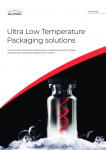In-Pharma Technologist Special Feature
Focus on: radio frequency identification (RFID) technology
frequency identification (RFID) technology that will soon
revolutionise pharmaceutical supply chain management.
RFID has long been touted as the future of logistics for all companies by allowing retailers and suppliers to track and trace goods throughout the supply chain. While retailers are pushing suppliers to embrace the technology, the costs involved and skepticism of the benefits have dampened manufacturer enthusiasm. At present, barcodes and serial numbers allow items to be identified at make and model level. RFID tags can ultimately be used to identify an individual item. When these tags pass through a field generated by a compatible reader, they transmit this information back to the reader, thereby identifying the object. The information carried can provide details of place and date of manufacture, a log of an items journey through the supply chain, and all other manner of information that could be used to improve the tracing, tracking and movement of goods. Being able to identify items at an individual level has huge implications across several industries, particularly the pharmaceutical industry, which is increasingly being challenged by the product tampering and counterfeit drug issues that are arising through a lack of secure and accountable supply chains. Furthermore, in the event of drug scares, a precise recall of the exact goods likely to be affected can be made, rather than a wide scale operation to recover all items with a certain serial number, proving much more efficient and cost-effective. Tracking individual items is also helping to improve the efficiency of the supply chain and logistics. Being able to track items allows greater stock management. Automatic readers can provide stock level updates. A reader interfacing with ordering software can conceivably automatically re-order when stocks are running low. The applications of RFID reach far beyond the warehouse though. Individual item identification will enable manufactures to pinpoint the exact ingredients used to produce an item. Traceability is increasingly on the agenda of drug safety regulators in many countries, and RFID will extend its reach and effectiveness as the technology develops, proliferates and becomes more cost-effective. Meanwhile, US retailing giants such as Wal-Mart and Metro have already set mandates forcing food manufacturers to make investments into systems and tags and some large pharmaceutical firms are beginning to follow suit and use the technology for some of their large pricetag items. In fact, the pharmaceutical and healthcare industry is now the second largest adopter of RFID technology, with 18 per cent of suppliers and 14 per cent of customers in this field now piloting or using RFID. As a result, the market for RFID tags in healthcare is predicted to explode from $90m (€70m) in 2006 to $2.1bn in 2016. However, the form RFID takes across the pharmaceutical industry depends on the sometimes conflicting needs and expectations of both suppliers and manufacturers. Manufacturers are searching for a cheap RFID solution to make it economically viable, especially for individual lower value goods. While tagging whole pallets becomes common due to the low cost against the value, using the RFID on individual items is as far away as 2016 according to recent market analyst report published earlier this year. IDTechEx said that for item-level tagging to become widespread in low cost goods, the technology will have to evolve. Cases are beginning to be fitted with RFID, edging closer towards individual item identification. Developments, such as RFID ink, will provide the industry with the 'one cent tag' that is commercially viable for use on lower cost individual items - but not until 2016, according to predictions. Until then, re-usable tags may provide a cost effective solution, although not for low value goods in packaging that is likely to be discarded. Re-usable tags are more likely to feature at the other end of the market for high value goods where tags can be removed and returned, such as meat carcasses. Indeed, RFID tags are becoming available that are resistant to irradiation and temperature, and robust against other damage. Many manufacturers and retailers see possibilities the technology can offer and have expectations that it could radically change business. However, while some longer term objectives converge and diverge, today's main issues are how can those prepared to embrace the technology find a global standard to communicate through, while working with those lagging behind. The answer lies with finding a standard, a denominator within RFID that can be displayed on or in something everyone can use. Standards, such as Electronic Product Code (EPC) are currently being tested which will allow companies and regulators to share information, thus speeding up the supply chain and cutting down on errors. RFID is also being incorporated into labels that display part of the information held on the tags, enabling those without the means to receive the all data, to at least be able to read some of it. Some might say, for now at least, behind every great barcode, lies an RFID tag.










